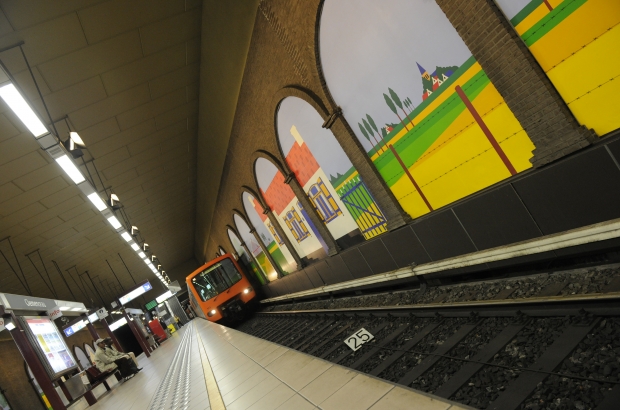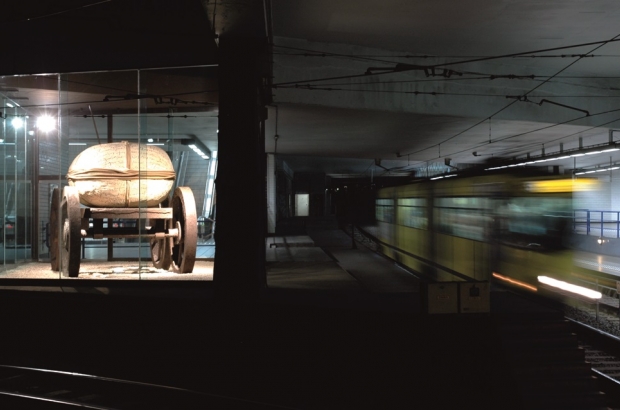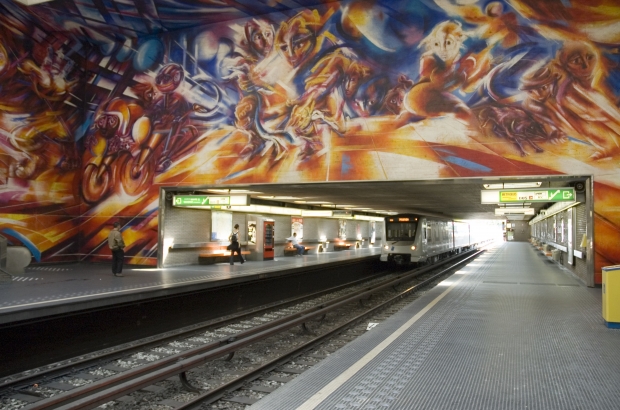- Daily & Weekly newsletters
- Buy & download The Bulletin
- Comment on our articles
Art on the metro: A journey through Belgian art history
Even the most distracted tourist or jaded commuter will have noticed that there’s art on the Brussels metro. But just how much there is – 82 works in 58 stations – may come as a surprise. Most of the artists are Belgian, by birth or long residence, making the metro a fascinating, idiosyncratic and highly selective guide to the nation’s contemporary art.
Brussels was late to develop an urban underground railway, only beginning plans in earnest in the 1960s. Its first underground tramways – the pre-metro – opened in 1969, followed by the first metro line in 1976. This was more than a century after London went underground, and over 70 years after Paris and New York.
But Brussels was a pioneer when it came to filling its metro with art. The idea was that art would help create an open, welcoming transport system in which each station had its own identity. A secondary aim was to bring contemporary art to a public that would not necessarily seek it out in museums and galleries.
This was particularly appealing to artists in Belgium’s geometric abstraction movement. They believed their art had a role to play improving modern urban life, and getting it into a public space as busy as the new metro was an opportunity not to be missed. Many of them submitted projects and as a consequence geometric abstraction is well represented across the network. Pol Bury’s angular sculptures point in all directions from the ceiling at Bourse, Hilde Van Sumere’s large marble disk, Moving Triangle, ushers travellers into Osseghem, and Walter Leblanc’s abstract typographies loom over the platforms at Elisabeth.
Other artists selected early on were committed to public art for ideological reasons, such as the communist Roger Somville, whose immense fresco of modern life, Our Times, dominates Hankar station. He had been part of the militant Forces Murales movement along with Edmond Dubrunfaut, whose work can be seen at Louise, renovations permitting.
After geometric abstraction, perhaps the best represented art movement is the Cobra group, which formally ended in the 1950s. Its Belgian alumni include Pierre Alechinsky and Christian Dotremont, who share a spot at Delta with their logogrammes, while Jan Cox’s painting The Fall of Troy hangs over a tunnel at Herrmann-Debroux, the end of the line. Serge Vandercam’s hand-shaped birds fly over the platforms at Joséphine-Charlotte, while Reinhoud d’Haese creates an impression of rushing commuters in copper at Osseghem.
Belgian surrealism is represented at Bourse by Paul Delvaux, still alive when the metro was spreading. And by sleight of hand the system retrospectively covers the Art Nouveau of Victor Horta, incorporating ironwork and stained glass from buildings he designed in the station that bears his name.
Other artists are so idiosyncratic they defy categorisation, such as Octave Landuyt and Jephan de Villiers. Then there are image makers who have slipped in from other disciplines, such as film-maker Raoul Servais at Houba Brugmann and jeweller Emile Souply at Botanique.
Over the decades, two broad guiding principles have shaped the selection of art for the metro. The first is that accessibility should even out across the system, with more challenging work in one station balanced by something easily understood in another. This explains Stockel’s crowd-pleasing fresco of characters from the Tintin comics, for which Hergé apparently drew sketches before his death in 1983.
The second principle is that the artist should respond in some way to the setting. Early work often referenced the transport system itself, such as Delvaux’s Our Old Brussels Tramways at Bourse or Marc Mendelson’s Happy Metro to You at Parc. But by the 1980s work started to appear responding to specific locations. Sometimes this was literal, as in Jan Burssens’ painting of black ponds for Etangs Noirs station. Or it was more obscure, such as the figures in Yves Bosquet’s Stuyvenbergh, which refer to Queen Elisabeth’s last residence at nearby Stuyvenbergh Castle.
Past 2000 a more socially aware tone appears, with art reflecting communities and their issues. At Rogier, for example, a mosaic by Roobjee Pjeroo and Gino Tondat is the result of a community project on poverty, while Vincen Beeckman’s Casting covers columns on the platform at Anneessens with photographs taken in the homes of people living in the neighbourhood.
Beeckman is also part of an influx of photographers invited to decorate stations after 2000. Others include Marin Kasimir at CERIA, Stephan Vanfleteren at Gare de l’Ouest and the two most recent installations, Vegetable Miniatures by Bob Verschueren and People in Motion by Michel Dusariez, both unveiled at Demey in 2012.
All photos courtesy Stib
This article first appeared in The Bulletin's Best of Belgium 2015





















